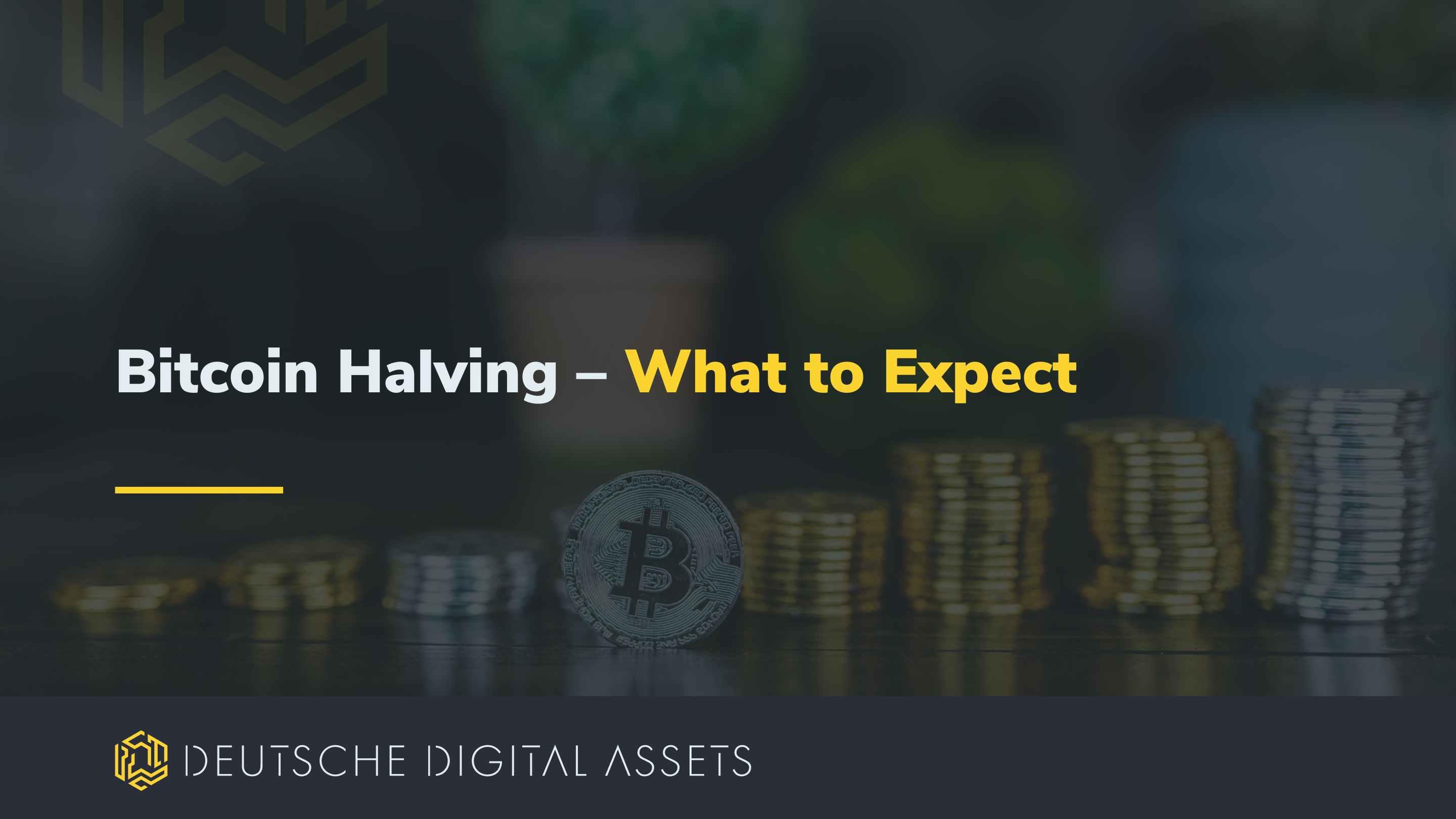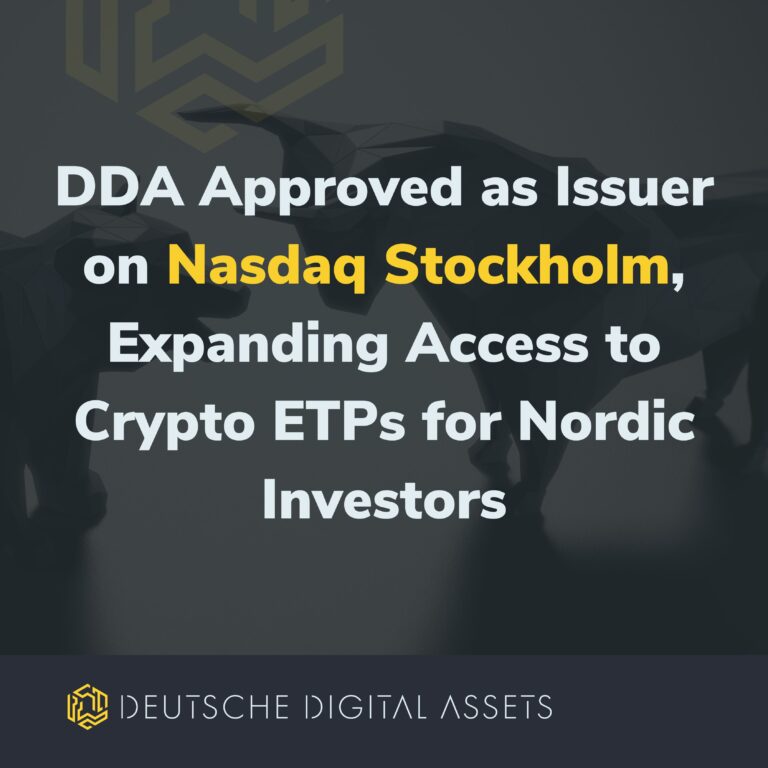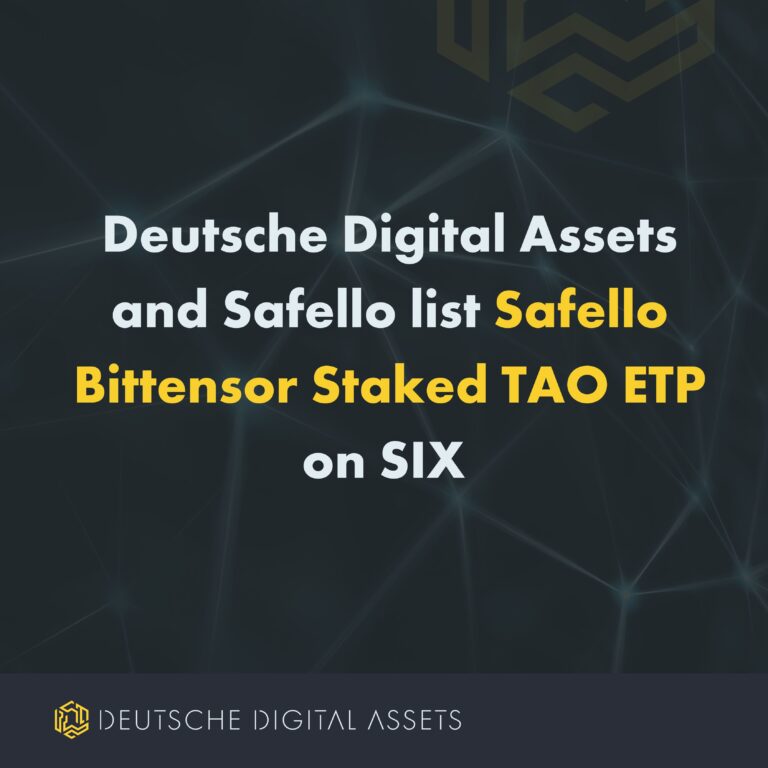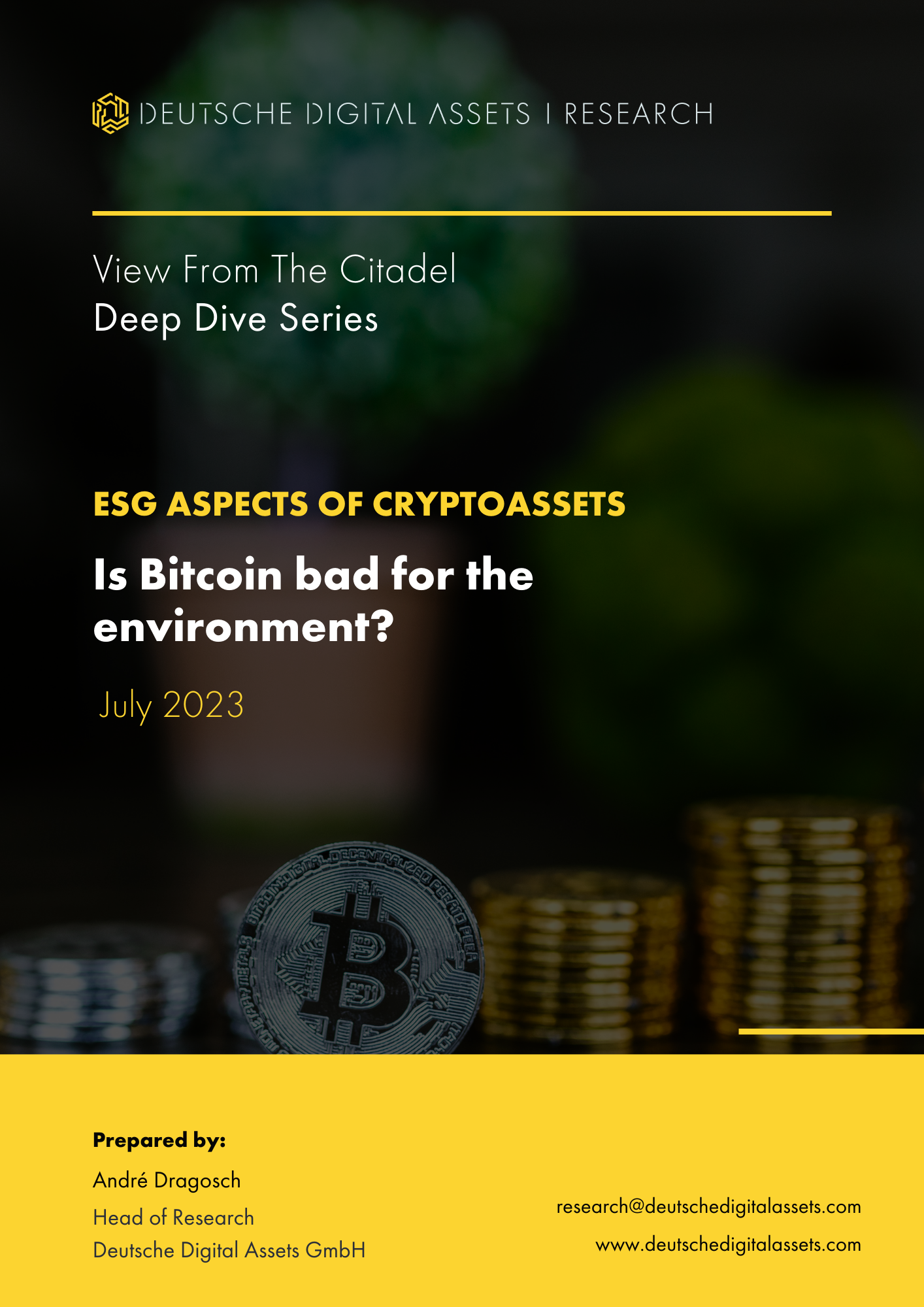
Bitcoin-Halving - Was ist zu erwarten?
von Dominik Poiger, Leiter Produktmanagement, DDA
Das mit Spannung erwartete Ereignis der Bitcoin-Halbierung im April 2024 sendet Schockwellen durch den Kryptowährungsmarkt. Der Zeitpunkt ist noch nicht bekannt, aber die Halbierung wird im Block 840.000 stattfinden, der voraussichtlich am 19. April 2024 gemined wird. Experten sagen eine parabolische Hausse voraus, die durch eine einzigartige Konvergenz von Angebot und Nachfrage angeheizt wird.
Was ist die Bitcoin-Halbierung?
Das Kernprinzip von Bitcoin ist sein begrenztes Angebot - nur 21 Millionen Bitcoins werden jemals geschürft. Die Halbierung, die die Blockbelohnung für Miner halbiert, schränkt den Fluss neuer Bitcoins auf den Markt weiter ein. Die Halbierung ist programmatisch so eingestellt, dass sie alle 210.000 Blöcke (etwa alle 4 Jahre) stattfindet. Bei dieser Halbierung wird die Blocksubvention (d. h. die neuen Bitcoins, die pro Block geschürft werden) von 6,25 BTC auf 3,125 BTC pro Block reduziert.

Als das Bitcoin-Netzwerk gestartet wurde und der erste Block gemined wurde, gab es eine Subvention von 50 Bitcoins für jeden Block. Während der ersten Halbierung im Jahr 2012 wurde diese auf 25 Bitcoins reduziert. Bei der zweiten Halbierung im Jahr 2016 wurde die Subvention dann auf 12,5 Bitcoins pro Block reduziert. Die letzte Halbierung fand im Mai 2020 statt, als die Subvention auf 6,25 Bitcoins pro Block halbiert wurde.
Die Bitcoin-Halbierung hat weitreichende Folgen für das Bitcoin-Ökosystem und den Markt selbst. Die offensichtlichste Auswirkung ist die Verringerung des Angebotswachstums an neuen Bitcoins, die täglich geschürft werden, was zu einem disinflationären Effekt führt. Da weniger Bitcoins pro Block geschaffen werden, verlangsamt sich die Rate, mit der neue Bitcoins in Umlauf gebracht werden, dramatisch, was bedeutet, dass weniger Bitcoins auf den Markt kommen.
Das Vertrauen des Inhabers schafft eine Rückkopplungsschleife
Sowohl langfristige als auch kurzfristige Inhaber zeigen ein unerschütterliches Vertrauen in die Zukunft von Bitcoin. Diese "Hodling"-Mentalität, bei der sich die Anleger dafür entscheiden, ihre Bitcoin nicht zu verkaufen, verknappt das verfügbare Angebot weiter, das sich bereits auf einem sehr niedrigen Niveau befindet (wie aus den Blockchain-Daten ersichtlich ist). Da nur eine begrenzte Anzahl von Münzen zum Kauf zur Verfügung steht und das Interesse von Institutionen wächst, ist die Bühne für einen möglichen Anstieg des Bitcoin-Preises bereitet.
Die möglichen Auswirkungen der Halbierung auf den Preis
Die Halbierung ist zwar nicht garantiert, hat aber das Potenzial, den Bitcoin-Preis erheblich zu beeinflussen. In der Vergangenheit gab es eine Korrelation zwischen der Halbierung und dem Preisanstieg, aber das garantiert nicht das gleiche Ergebnis im Jahr 2024.
Die Logik hinter dem potenziellen Preisanstieg ist, dass die Halbierung das Angebot an neuen Bitcoins, die auf den Markt kommen, reduziert, während die Nachfrage aufgrund der wahrgenommenen Knappheit steigen könnte. Da die Miner weniger verkaufen und die Anleger potenziell mehr kaufen wollen, könnte der Preis steigen. Dieses Narrativ wurde besonders nach der Einführung von Bitcoin-ETFs mit Sitz in den USA hervorgehoben, die in kurzer Zeit ein erhebliches verwaltetes Vermögen angezogen haben.
Es ist wichtig zu wissen, dass diese Auswirkungen möglicherweise nicht sofort eintreten. Analysen verschiedener Marktteilnehmer deuten darauf hin, dass es bis zu 100 Tage nach der Halbierung dauern kann, bis eine statistisch signifikante Preisveränderung eintritt.
Die Halbierung ist ein absoluter Umbruch in der Bitcoin-Mining-Industrie, der weniger effiziente Operationen aufdeckt, da die Einnahmen der Miner von einem Tag auf den anderen halbiert werden. In Schwierigkeiten geratene Miner werden versuchen, Münzen aus ihren Reserven zu verkaufen (falls sie welche haben), um ihren Betrieb zu finanzieren - was den Verkaufsdruck erhöhen könnte. Profitable Miner könnten sich zurücklehnen und abwarten, bis sich der Staub gelegt hat, um dann wieder aggressiver mit Fusionen und Übernahmen zu werden oder Münzen in der Bilanz zu halten.
Mit der zunehmenden Verknappung durch diese Halbierungen hat die Volatilität von Bitcoin im Laufe der Zeit strukturell abgenommen, wie die folgende Grafik zeigt:

Während die durchschnittliche Volatilität in der ersten Epoche 161% p.a. betrug, sank sie in der zweiten, dritten und vierten Epoche auf 107% p.a., 78% p.a. und 63% p.a.. Mit dem strukturellen Rückgang der Volatilität und einer zunehmenden Knappheit, die derzeit mit der von Gold vergleichbar ist (Stock-to-Flow-Ratio von ~60 Jahren), ist auch die Korrelation von Bitcoin mit den Inflationserwartungen im Laufe der Zeit gestiegen.
Basierend auf dem zugrundeliegenden Bitcoin-Algorithmus wird der Grad der Knappheit mit der Zeit weiter zunehmen. Nach der nächsten Halbierung wird das Stock-to-Flow-Verhältnis von Bitcoin im Vergleich zu Gold bereits doppelt so hoch sein (~124 Jahre für Bitcoin gegenüber ~60 Jahren für Gold). Bis 2032 wird das Stock-to-Flow-Verhältnis von Bitcoin mehr als 500 Jahre betragen.
Wir gehen davon aus, dass sich der strukturelle Rückgang der Bitcoin-Volatilität mit jeder Halbierung und dem Anstieg der technologischen Akzeptanz fortsetzen wird. Daher erwarten wir auch, dass die Korrelation und Sensitivität von Bitcoin gegenüber Inflationserwartungen noch weiter zunehmen wird.
Eine zunehmende Akzeptanz von Bitcoin als Spar- und Zahlungstechnologie wird die Volatilität auch strukturell verringern, da die Anleger und Nutzer heterogener werden, was in der Regel eine dämpfende Wirkung auf die Volatilität hat.
Die Quintessenz
Die Bitcoin-Halbierung wird von der gesamten Branche mit Spannung erwartet, da sie erhebliche Auswirkungen auf den Bitcoin-Kurs und damit auf die gesamte Branche haben kann. Jede Vorhersage über den Bitcoin-Preis ist aus unserer Sicht nicht gerechtfertigt, da die verschiedenen Auswirkungen in allen vergangenen Halbierungszyklen unterschiedlich waren. Aber die Halbierung verringert den Zufluss neuer Bitcoin in den Umlauf, was zu einer erhöhten Nachfrage bei wahrgenommener Knappheit führen kann. Da die Miner weniger liefern und (institutionelle) Investoren ein erhöhtes Interesse zeigen, könnte die Bühne für einen potenziellen Anstieg des Bitcoin-Wertes bereitet sein.
WICHTIGE INFORMATIONEN
Die in diesem Artikel enthaltenen Materialien und Informationen dienen nur zu Informationszwecken.
Die Deutsche Digital Assets GmbH, ihre verbundenen Unternehmen und Tochtergesellschaften fordern nicht zu Handlungen auf der Grundlage dieses Materials auf. Dieser Artikel ist weder eine Anlageberatung noch eine Empfehlung oder Aufforderung zum Kauf von Wertpapieren.
Die Wertentwicklung ist unvorhersehbar. Die Wertentwicklung in der Vergangenheit ist daher kein Hinweis auf die zukünftige Wertentwicklung.
Sie erklären sich damit einverstanden, Ihre eigenen Nachforschungen anzustellen und Ihre Sorgfaltspflicht zu erfüllen, bevor Sie eine Anlageentscheidung in Bezug auf die hier besprochenen Wertpapiere oder Anlagemöglichkeiten treffen.
Unsere Artikel und Berichte enthalten zukunftsgerichtete Aussagen, Schätzungen, Projektionen und Meinungen. Diese können sich als wesentlich ungenau erweisen und unterliegen naturgemäß erheblichen Risiken und Unwägbarkeiten, die außerhalb der Kontrolle der Deutsche Digital Assets GmbH liegen.
Wir gehen davon aus, dass alle hierin enthaltenen Informationen korrekt und zuverlässig sind und aus öffentlichen Quellen stammen. Diese Informationen werden jedoch "wie besehen" ohne jegliche Garantie präsentiert.















